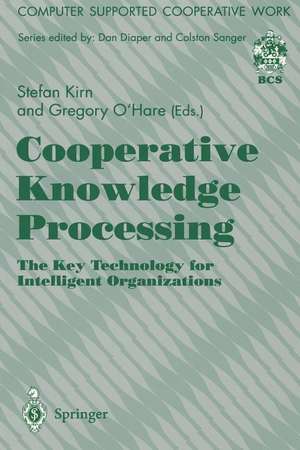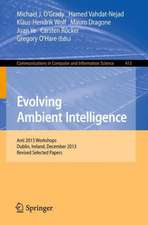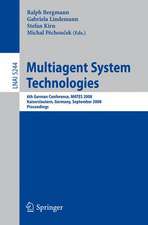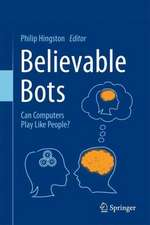Cooperative Knowledge Processing: The Key Technology for Intelligent Organizations: Computer Supported Cooperative Work
Editat de Stefan Kirn, Gregory O'Hareen Limba Engleză Paperback – 26 noi 1996
Din seria Computer Supported Cooperative Work
- 20%
 Preț: 1044.25 lei
Preț: 1044.25 lei - 20%
 Preț: 650.59 lei
Preț: 650.59 lei - 20%
 Preț: 647.61 lei
Preț: 647.61 lei - 20%
 Preț: 638.55 lei
Preț: 638.55 lei - 20%
 Preț: 334.53 lei
Preț: 334.53 lei - 20%
 Preț: 328.79 lei
Preț: 328.79 lei - 20%
 Preț: 334.71 lei
Preț: 334.71 lei - 20%
 Preț: 330.90 lei
Preț: 330.90 lei - 20%
 Preț: 328.79 lei
Preț: 328.79 lei - 20%
 Preț: 649.28 lei
Preț: 649.28 lei - 20%
 Preț: 643.50 lei
Preț: 643.50 lei - 20%
 Preț: 329.91 lei
Preț: 329.91 lei - 15%
 Preț: 642.83 lei
Preț: 642.83 lei - 20%
 Preț: 648.11 lei
Preț: 648.11 lei - 20%
 Preț: 996.40 lei
Preț: 996.40 lei - 20%
 Preț: 413.81 lei
Preț: 413.81 lei - 20%
 Preț: 336.02 lei
Preț: 336.02 lei - 20%
 Preț: 346.10 lei
Preț: 346.10 lei - 20%
 Preț: 330.24 lei
Preț: 330.24 lei - 20%
 Preț: 982.36 lei
Preț: 982.36 lei - 20%
 Preț: 329.11 lei
Preț: 329.11 lei - 20%
 Preț: 987.32 lei
Preț: 987.32 lei - 20%
 Preț: 641.34 lei
Preț: 641.34 lei - 20%
 Preț: 648.26 lei
Preț: 648.26 lei - 20%
 Preț: 995.89 lei
Preț: 995.89 lei - 20%
 Preț: 643.63 lei
Preț: 643.63 lei - 20%
 Preț: 988.98 lei
Preț: 988.98 lei - 20%
 Preț: 328.42 lei
Preț: 328.42 lei - 20%
 Preț: 988.81 lei
Preț: 988.81 lei - 20%
 Preț: 643.30 lei
Preț: 643.30 lei - 20%
 Preț: 987.17 lei
Preț: 987.17 lei - 20%
 Preț: 329.58 lei
Preț: 329.58 lei - 20%
 Preț: 309.58 lei
Preț: 309.58 lei - 20%
 Preț: 330.42 lei
Preț: 330.42 lei - 5%
 Preț: 365.82 lei
Preț: 365.82 lei - 20%
 Preț: 650.08 lei
Preț: 650.08 lei - 20%
 Preț: 334.38 lei
Preț: 334.38 lei - 20%
 Preț: 645.79 lei
Preț: 645.79 lei - 20%
 Preț: 650.40 lei
Preț: 650.40 lei - 20%
 Preț: 333.88 lei
Preț: 333.88 lei - 20%
 Preț: 1263.81 lei
Preț: 1263.81 lei - 20%
 Preț: 830.58 lei
Preț: 830.58 lei - 20%
 Preț: 704.70 lei
Preț: 704.70 lei
Preț: 647.79 lei
Preț vechi: 809.73 lei
-20% Nou
Puncte Express: 972
Preț estimativ în valută:
123.97€ • 134.61$ • 104.13£
123.97€ • 134.61$ • 104.13£
Carte tipărită la comandă
Livrare economică 22 aprilie-06 mai
Preluare comenzi: 021 569.72.76
Specificații
ISBN-13: 9783540199519
ISBN-10: 3540199519
Pagini: 324
Ilustrații: XXV, 296 p. 25 illus.
Dimensiuni: 155 x 235 x 17 mm
Greutate: 0.48 kg
Ediția:1st Edition.
Editura: SPRINGER LONDON
Colecția Springer
Seria Computer Supported Cooperative Work
Locul publicării:London, United Kingdom
ISBN-10: 3540199519
Pagini: 324
Ilustrații: XXV, 296 p. 25 illus.
Dimensiuni: 155 x 235 x 17 mm
Greutate: 0.48 kg
Ediția:1st Edition.
Editura: SPRINGER LONDON
Colecția Springer
Seria Computer Supported Cooperative Work
Locul publicării:London, United Kingdom
Public țintă
ResearchCuprins
1 Cooperative Knowledge Processing — Research Framework and Applications.- 1.1 Introduction.- 1.2 Organizational Paradigms: Evolving Role of Information Technology.- 1.3 New Organizational Strategies: A Brief Review.- 1.4 Technology of Cooperative Knowledge Processing.- 1.5 Application Perspectives.- 1.6 Summary.- 2 Coordination in Organizations.- 2.1 Introduction.- 2.2 Organizational Coordination.- 2.3 Computers and Coordination.- 2.4 Design Issues and Applications.- 2.5 Example of a Strategy Related Coordination System.- 3 Communication-Oriented Approaches to Support Multi-User Processes in Office Work.- 3.1 Introduction.- 3.2 Office Work.- 3.3 Requirements to Support Multi-User Processes in Office Work.- 3.4 Communication Orientated Approaches for Supporting Office Work.- 3.5 Evaluation of the Approaches Presented.- 3.6 Summary.- 4 Coordinating Human and Software Agents through Electronic Mail.- 4.1 Introduction.- 4.2 Software Support Tools.- 4.3 Modes of Interaction with Adcmail.- 4.4 The Coordination Mechanism.- 4.5 Conclusions.- 5 User Control over Coordination Mechanisms in Office Information Systems.- 5.1 Introduction.- 5.2 Office Model in ECHOES.- 5.3 Collaborative Work Scenarios.- 5.4 Modeling Coordination Mechanisms in ECHOES.- 5.5 Related Research.- 5.6 The ECHOES Project.- 5.7 Summary and Conclusion.- 6 Computational Support for the Management of Social Processes within Organizational Teams.- 6.1 Introduction.- 6.2 The Cooperative Requirements Capture (CRC) Project.- 6.3 The CRC Prototype.- 6.4 Description of the CRC User Interface.- 6.5 Why Facilitation?.- 6.6 The Role of the Facilitator.- 6.7 CRC Support for the Social Process.- 6.8 Facilitator Support within CRC Prototype.- 6.9 Future Work.- 6.10 Conclusions.- 7 The Wolf in Sheep’s Clothing: HowLocks Can Gently Control Collaboration.- 7.1 Introduction.- 7.2 Concurrency Control and Cooperative Work.- 7.3 Locks in the Context of Nested Transactions.- 7.4 Rules on Locks and Notification Services.- 7.5 Object-Related Locks.- 7.6 Subject-Related Locks.- 7.7 Conclusion.- 8 Enhancing Organizational Intelligence through Cooperative Problem Solving.- 8.1 Introduction.- 8.2 Organisational Intelligence (OI).- 8.3 Incorporating Organizational Intelligence into Distributed AI Systems.- 8.4 The Contribution of Distributed AI to the Intelligence of Computerized Enterprises.- 9 Organizational Intelligence and Negotiation Based DAI Systems — Theoretical Foundations and Experimental Results.- 9.1 Introduction.- 9.2 Theoretical Foundations.- 9.3 Extension of Contract Net-Based Systems by OI Components.- 9.4 Realization in a Scenario.- 9.5 Presentation and Evaluation of the Results.- 9.6 Conclusion.- 10 Incorporating Organizational Design Principles and Experiences into the Design and Implementation of Multi Agent Systems.- 10.1 Introduction.- 10.2 Distributed Artificial Intelligence (DAI).- 10.3 Organizational Theory (OT).- 10.4 A DAI Perspective on Organisations.- 10.5 Synthesizing DAI & OT.- 10.6 Design Principles.- 10.7 Agent Oriented Programming (AOP).- 10.8 Warehouse World.- 10.9 Design and Experimental Testing of Emergent Organizations.- 10.10 Conclusions.- 11 Coordination Protocols.- 11.1 Introduction.- 11.2 From Speech Acts to Dialogs.- 11.3 Protocols.- 11.4 Conclusion.- 12 Modeling Distributed Industrial Processes in a Multi-Agent Framework.- 12.1 Introduction.- 12.2 The Application Domain.- 12.3 A Specification Framework for Multi-Agent Systems.- 12.4 Formal Model and Specification of a Multi-Agent System.- 12.5 Discussion.- 13 Utilitarian Coalition FormationBetween Autonomous Agents for Cooperative Information Gathering.- 13.1 Introduction.- 13.2 A Brief Introduction to some Related Research Areas.- 13.3 The FCSI-Agent: Functionality and Architecture.- 13.4 Coalitions of FCSI Agents.- 13.5 IDEAS — an Environment for the Implementation of FCSI Agents.- 13.6 Conclusion and Discussion.- 13.7 Appendix.- Epilogue: Computers, Networks and the Corporation.- References.- Name Index.



















